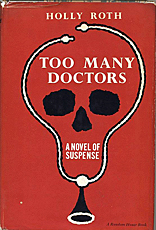REVIEWED BY DAN STUMPF:
THE WHITE GORILLA. Fraser & Merrick, 1945. Ray Corrigan, Lorrain Miller, Charles King and Francis Ford. Written, produced & directed by Harry L. Fraser.

Dammit, I felt like watching a Killer Ape movie, and this time it was The White Gorilla, made in 1945 and 1927. No, that’s not two versions, it’s actually one movie made nearly twenty years apart.
To better understand The White Gorilla you need to know something about its auteur, Harry L. Fraser, who also worked under the names Arthur Borris, Wayne Carter, Harry P. Christ, Harry S. Christ, Harry C. Crist, Harry P. Crist, Harry Crist, Miller Easton, Weston Edwards, Harry Frazer, Clint Johnson, Harry O. Jones, Harry Jones, Timothy Munro, Monroe Talbot, Munro Talbot, Victor von Resarf and Edward Weston. Those who profess to enjoy the films of Ed Wood need to take a look at Fraser’s oeuvre and recognize him as the spiritual father of bad movies. Fraser worked in film from the silent days to the 50s with only the faintest glimmer of talent, and most times not even that, but he brought his films in on time and under budget, which kept him gainfully employed at studios where they wanted it done Tuesday.
According to Fraser’s memoirs (I Went That-a-Way, Scarecrow, 1990) it took three and a half days in 1945 to film White Gorilla, and looking at it today, one can only wonder how he spent three of them. Most of the footage shot in ’45 consists of Ray “Crash†Corrigan sitting around a cardboard mock-up of a Jungle Trading Post telling Charles King and Francis Ford what happened to “the Rogers safari.†Every so often we flash-back to scenes of Crash walking through the woods behind somebody’s back yard, which is supposed to be the African jungle, looking off-screen and seeing… well, whatever grainy old footage of wildlife happened to be handy at the time, including tigers and new world monkeys.
But it gets better. As Crash continues his story, the movie flash-backs to old footage from Perils of the Jungle, shot in 1927. And this footage is so blatantly mis-matched as to provoke disbelieving laughter from anyone who sees it: the actors are all made-up in classic silent-movie style, with rouged lips and eye shadow, they mime their parts with pre-talkie emphasis, and they seem to move at the wrong speed. So we get these 1945 shots of Ray “Crash†Corrigan standing in somebody’s shrubs, saying voice-over, “…as I watched, the lions surrounded Rogers’ camp…†and then we cut-away to the hilarious footage of what he’s supposedly watching. And of course, since all this was filmed eighteen years earlier, Corrigan can’t interact with anyone in the Rogers safari, so he – or the writer — has to keep coming up with excuses like, “…with no ammunition, I could only watch helplessly while the natives…†or “…with the river between us, I could only watch helplessly while the crocodile…â€
Well, he’s not the only one watching helplessly, but White Gorilla gets better still. Sometimes we cut away from Crash to more recent footage, filmed that same weekend, of someone in a white Gorilla outfit lumbering through the woods. Eventually the guy in the white Gorilla suit runs into someone in a black Gorilla suit and the two mimic fighting for a few minutes. Then the camera simply seems to lose interest and we cut back to Corrigan or to the silent movie for a few chapters till the refrain starts in again: someone in a white Gorilla outfit lumbering through the woods, running into someone in a black Gorilla suit, whereupon the two mimic fighting for a few minutes, till the camera loses interest and…. It’s like being caught in a time warp. I have it on good authority that Crash played at least one of the battling apes, so this film was quite a stretch for him dramatically.
White Gorilla, in short, is one of those films so jaw-droppingly awful as to be truly fun to watch, and I recommend it to anyone who can approach it in the proper spirit. While we were watching it, I happened to mention to my wife that the writer-director had written a memoir, and she responded, “Because those who forget the past have to repeat it?â€
